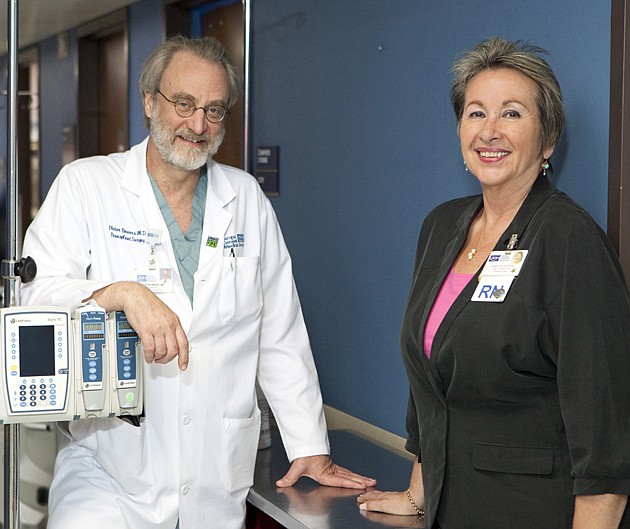Doctors and administrators at Tampa General Hospital's organ transplant program say being big was never the goal, but a recent feat turns that premise upside down.
The accomplishment: The unit, with 500 transplants performed, moved up six spots on the list of highest volume transplant centers in the country in 2011, from 10th to fourth.
Only the UCLA Health System in Los Angeles, California Pacific Medical Center in San Francisco and New York-Presbyterian Hospital performed more transplants in 2011, according to Organ Procurement and Transplantation Network data. There are 258 solid organ transplant centers in the country, and the TGH program is the largest in the Southeast.
Moreover, OPTN, a division of the U.S. Department of Health & Human Services, reported all five of TGH's specific transplant programs were among the 10 busiest centers in the country last year. It's the first time that's happened in the history of the TGH transplant program, which dates back to 1974, when the hospital first successfully performed a heart transplant. Tampa General is a nonprofit hospital, with 1,018 beds and 6,900 employees. It had about $1.2 billion in 2011 revenues.
The five transplant programs at TGH are heart, kidney, kidney-pancreas, liver and lung. The hospital has also performed pediatric kidney transplants. But the fact that solid organs are literal life-and-death commodities, where transplant program growth is totally predicated on supply of those organs, is what makes the success standout, hospital officials say.
“It's not a widget,” says Angie Korsun, the TGH transplant program administrator, “where you can turn around and say 'if I set my machine at this speed, I can make 1,000 widgets, instead of 750 widgets.'”
Dr. Victor Bowers, one of the lead TGH transplant surgeons, adds that the sheer number of transplant surgeries pales when compared to how people do, and live, after they get replacement organs. “You can increase your numbers,” Dr. Bowers says, “but if you don't have good patient results, then you're not really doing a service.”
Nonetheless, a large, and growing, organ transplant program can provide a big boost to a medical center. For one, the notoriety can raise community awareness of the entire hospital. Plus, a publicized organ donor story can draw interest in a transplant program's lifeline: More donors and more organs.
The revenues a transplant program can generate are also significant. For example, the average estimated hospital admission fee nationwide for a heart transplant patient in 2011 was $634,300, according to the United Network of Organ Sharing. The nonprofit network helps the federal government manage the nation's organ transplant system.
The average hospital admission fee for a single lung transplant in 2011 was $302,900, the network estimates. Other average estimates from the network: A liver transplant was $316,900; a pancreas was $108,900; and a kidney transplant was $91,200.
TGH officials declined to elaborate on specific transplant program revenues.
“It's profitable, but it's not as profitable as people may think,” says Korsun. “Even with all the technology out there, it's still a labor intensive business and an expensive undertaking. This program certainly utilizes a significant amount of the hospital's resources.”
Not only for the cost of the surgery, says Korsun, but in other key areas, like equipment, training and employees. The transplant program utilizes 120 hospital employees at any given time, from intensive care nurses to dietary staff to surgeons.
Symbiotic success
The TGH transplant program isn't only one of the biggest in the country, it's also one of the more unique. That's because it isn't run exclusively out of a teaching hospital, which is the foundation for most other large transplant programs. The hospital is connected with the USF Health Morsani College of Medicine, but most of the surgeons aren't professors.
Instead, the transplant program is a partnership with The LifeLink Transplant Institute, a subsidiary of Tampa-based LifeLink Foundation. A nonprofit overseen by the National Organ Transplant Act Congress passed in 1984, LifeLink procures the organs TGH uses in the transplant surgeries. The group covers 15 counties in west and central Florida, including the entire Gulf Coast except for Collier County, which is part of another organization.
The other side of the partnership, surgery and patient recovery, falls to the Tampa General Medical Group. That practice was created in 2010, and includes doctors who once only worked for LifeLink.
The partnership is symbiotic. “Our ability to perform 500 transplants is a direct result of LifeLink's ability to acquire the organs,” TGH President and CEO Ron Hytoff says in a press release.
Adds Korsun: “This isn't a situation where one person does this. Transplantation is truly something only a team can do.”
Korsun also says the TGH transplant program has a high tolerance for unusual cases — another aspect of the unit's uniqueness. “We do a number of high-risk patients that many other transplant centers wouldn't consider,” says Korsun. “I think that speaks to the talent we have.”
High-risk ranges from how sick a patient is to someone with an illness separate from the organs. A patient's age can complicate transplant surgery, too, much like the controversy generated when former U.S. Vice President Dick Cheney, at 71, recently received a heart transplant.
Bowers says TGH strives to make all transplant surgeries look routine. “When you pull it off, it seems as simple as getting a haircut,” says Bowers. “But it isn't. It's very complicated.”
Large needs
Medical complexities aside, the TGH transplant program faces several other potential hurdles to continued growth.
A constant one is organ supply. Nearly 140,000 people nationwide are on a waiting list for an organ transplant, according to TGH. The list is about 4,000 in Florida, including 600 people in the Greater Tampa area who await a kidney, says Dr. Bowers.
That's why organ donor education and outreach is a key focus at LifeLink. “We are completely dependent on the number of donors in the community,” says Bowers. “We have a huge patient supply and a huge need from our communities.”
The federal health care overhaul, currently in the hands of the U.S. Supreme Court, will also play a role in the future of the program, says Korsun. “(Transplant surgery) is an expensive process,” says Korsun. “Patients need to have insurance.”
The costs, furthermore, don't end after the surgery. For instance, anti-rejection medications, which help the body adjust to the organ, are one of the pricier post-operation costs. The first year, says Korsun, could cost a patient $20,000.
Korsun, a nurse who got into transplant work in New York more than 20 years ago, says another worry she has is state Medicaid funding. She kept close tabs on the situation in Arizona in 2010, when Gov. Jan Brewer cut Medicaid funding that covered some organ transplants. Some of that funding has since been restored.
While those outside threats loom, Korsun says her day-to-day focus remains the same: to grow smartly.
“Certainly, as an organization we want to grow (and) stay in this top stratosphere,” Korsun says. “But when you are growing you have to be careful about controlled growth. We always have to be fiscally prudent.”






